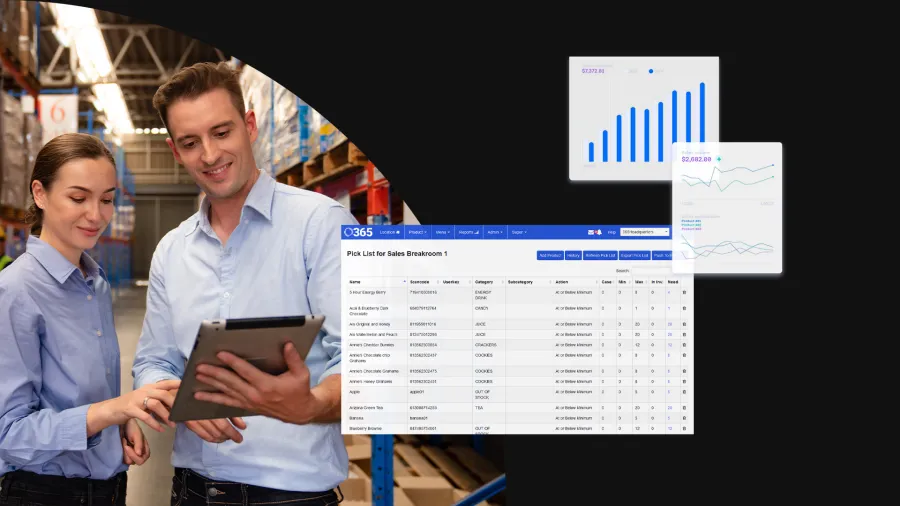Published • 14 Oct 2025
Running unattended retail shouldn't mean running blind. Every transaction, every restock, every promo tells a story about how your business performs — but if you can't see that story, you're guessing instead of managing.
That's where ADM, the back-end software behind the 365 ecosystem, comes in. It's the foundation for smarter, more profitable operations across micro markets, smart stores, and dining spaces, whether you manage five coolers or five hundred markets.
What Is ADM? The Data Foundation of Unattended Retail
Most systems stop at the sale. ADM doesn't.
ADM is the 365 platform that sits behind every kiosk, cooler, and mobile app. It takes the constant flow of sales, product, and inventory data and turns it into clear insights that you can use to make better decisions — in real-time.
Think of it as your operation's control center. You can see what's selling, track cash and inventory, spot issues before they become losses, and manage pricing or promotions across every location, all from one place.
And it's not reserved for large enterprises. ADM is built to help retail businesses of any size act like the big players from day one.
Why ADM Isn't Just for the Big Guys
You don't need a data department to run smarter retail; you just need the right view.
ADM provides smaller businesses with the same level of visibility and control that major organizations rely on. A single cooler or micro market owner can log in and see which items move quickly and which just take up space. They can adjust pricing, replace low performers, and grow profit without adding a single new cooler.
Meanwhile, a company with dozens of locations can use ADM's built-in trend analysis to understand what sells across different markets and times of day. It's one tool that scales from a handful of stores to hundreds.
In short: ADM helps small businesses look big — and helps big businesses act fast.
How ADM Helps You Run Smarter Retail
The most successful retail businesses aren't always the largest; they're the ones that know their numbers and act on them. ADM gives you that edge.
1. See What's Really Driving Revenue
Guessing what sells is expensive. ADM takes the guesswork out.
Reports like Product Sales, Product Canned, and Unsold Products show exactly which items are driving your revenue and which aren't worth reordering. These insights help you stock smarter, refine pricing, and focus on what moves.
2. Catch Losses Before They Snowball
Shrink and stales eat into margins quietly. ADM's Loss Prevention and Inventory Variance reports make those losses visible.
When every item movement is tracked — from add to sale to removal — you can see where something's off and correct it before it turns into waste.
3. Manage Efficiency in Real Time
Every dollar should be traceable. Cash Flow and Financial Recap reports show where funds are moving and when.
Add in real-time Dashboards and system Notifications, and you'll know the moment a kiosk goes offline or a store stops selling — before it affects your bottom line.
4. Turn Customer Behavior Into Business Intelligence
The data doesn't stop at operations. ADM ties directly into consumer insights.
Rewards, Promotion Analysis, and Consumer Purchase Summary reports reveal what motivates repeat visits and higher basket sizes. That means you can fine-tune your promotions and rewards based on real buying behavior, not assumptions.
Smarter Retail in Practice
Data is only valuable when it changes what you do next. ADM makes that easy.
Take a business running a PicoCooler Vision in a gym and a Stockwell in an apartment community. With ADM, they can see performance across both locations in real time, without logging into multiple systems or manually comparing reports.
At the gym, ADM's product reports show strong sales of protein snacks and bottled water but slower movement on energy drinks. At the apartment complex, a different trend appears: residents buy more late-night beverages and sweet snacks, but grab-and-go meals rarely sell out. ADM’s Item Stockout Report flags the fast movers that regularly run out, helping the business restock on time and prevent missed sales. Together, these insights make it clear each site needs a different mix.
By adjusting assortments and pricing for each environment — and tracking results in ADM's dashboards — the business improves sell-through at both sites and boosts total revenue within weeks. All of it happens through better data, not more equipment or labor. And as those insights compound, growth becomes easier to plan, allowing them to scale into new locations faster and with less risk.
In contrast, a regional foodservice group running dozens of markets uses ADM on a larger scale. Instead of checking performance location by location, their team relies on automated financial, inventory, and cash flow reports to identify patterns across regions. ADM's dashboards flag overstocked products in one area and recurring out-of-stocks in another, helping them rebalance purchasing and restocking cycles. Over time, those adjustments reduce spoilage by 15% and tighten cost control without changing staff workload.
Different business sizes, same outcome: smarter decisions that directly protect and grow revenue.
The Industry Standard for Smarter Retail
ADM brings the entire 365 system together, giving you one place to see, understand, and control your business. From kiosks and smart coolers to dining and mobile ordering, ADM keeps your data connected, clean, and actionable.
Other systems might give you a way to sell. ADM gives you the insight to run smarter.
Turn Insight Into Action
Smarter retail doesn't start with more equipment or more staff. It starts with seeing your business clearly.
If you already use 365, log into ADM and pull a report you've never used before — like Product Sales or Inventory Variance — and see what it tells you about your business.
If you're new to 365, talk to us about how ADM can help you turn data into better decisions and more profitable locations.

